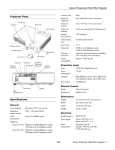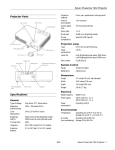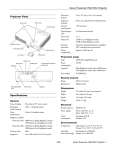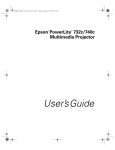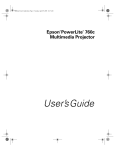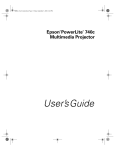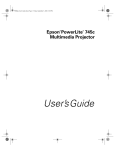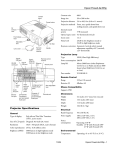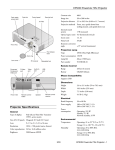Download Epson PowerLite 737c Specifications
Transcript
Epson PowerLite 737c Projector Projector Parts Focus ring Card slot Zoom ring Control panel Foot adjust lever Security lock I/R receiver Lens cap USB port (Type B) Front, rear, upside-down (ceiling mount) Internal sound system 1 W monaural Optical aspect ratio 4:3 (horizontal:vertical) Zoom ratio 1:1.2 Noise level 36 dB (Low Brightness mode) Mouse compatibility Supports USB (type B) Projection Lamp Exhaust air vent Audio port Projection methods Computer/ Component S-Video port Video port Video port USB port (Type A) Type UHE (Ultra High Efficiency) Power consumption 170 W Lamp life High Brightness mode: about 2000 hours Low Brightness Mode: about 3000 hours Part number V13H010L32 Remote Control Range 20 feet (6 meters) Batteries (2) Alkaline AAA Dimensions Rear adjustable foot Power inlet Speaker Height 2.7 inches (70 mm), feet retracted Width 10.9 inches (276 mm) Depth 7.6 inches (193 mm) Weight 3.9 lb (1.8 kg) Electrical Specifications Rated frequency 50/60 Hz AC Power supply 100 to 120 VAC, 2.7 A 200 to 240 VAC, 1.1 A Power consumption Operating: 240 W General Type of display Poly-silicon TFT active matrix Resolution (native format) 1024 × 768 pixels (XGA) Color reproduction 24-bit, 16.8 million colors Brightness (ANSI) 2000 lumens (High Brightness mode) 1500 lumens (Low Brightness mode) Contrast ratio 400:1 Image size (diagonal) 30 to 300 inches (0.8 to 7.6 meters) Projection distance 3.2 to 39.7 feet (1.0 to 12.1 meters) Environmental 2/05 Temperature Operating: 41 to 95 °F (5 to 35 °C) Storage: 14 to 140 °F (–10 to 60 °C) Humidity (non-condensing) Operating: 20 to 80% RH, Storage: 10 to 90% RH Epson PowerLite 737c Projector - 1 Epson PowerLite 737c Projector Safety and Approvals United States FCC 47CFR Part15B Class B (DoC) UL60950 Third Edition Canada ICES-003 Class B CSA C22.2 No. 60950 CE Marking Directive 73/23/EEC, 89/336/EEC IEC60950 Third Edition EN 55022, EN 55024 Compatible Video Formats The projector supports the video display formats listed below: Mode Refresh Rate (Hz) NTSC NTSC 4:43 PAL N—PAL M—PAL PAL—60 SECAM 60 60 50 50 60 60 50 HDTV (720p) HDTV (720p) HDTV (1080i) HDTV (1080i) SDTV (480p) SDTV (480p) TV480i TV480i 60 50 60 50 60 50 60 50 Compatible Computer Display Formats To project images from a computer, set the computer’s video card at a refresh rate (vertical frequency) compatible with the projector; see the following table for compatible formats. Some images are automatically resized to display in the projector’s “native” format (XGA). The frequencies of some computers may not allow images to display correctly; see your computer’s documentation for details. 2 - Epson PowerLite 737c Projector Mode Refresh Rate (Hz) Resolution VGA EGA VGA—60 VESA—72 VESA—75 VESA—85 70 60 72 75 85 640 × 350* 640 × 480* 640 × 480* 640 × 480* 640 × 480* SVGA—56 SVGA—60 SVGA—72 SVGA—75 SVGA—85 56 60 72 75 85 800 × 600* 800 × 600* 800 × 600* 800 × 600* 800 × 600* XGA—60 XGA—70 XGA—75 XGA—85 60 70 75 85 1024 × 768 1024 × 768 1024 × 768 1024 × 768 SXGA1—70 SXGA1—75 SXGA1—85 70 75 85 1152 × 864* 1152 × 864* 1152 × 864* SXGA2—60 SXGA2—75 SXGA2—85 60 75 85 1280 × 960* 1280 × 960* 1280 × 960* SXGA+60 SXGA+75 SXGA+85 60 75 85 1400 × 1050* 1400 × 1050* 1400 × 1050* SXGA3—60 SXGA3—75 SXGA3—85 60 75 85 1280 × 1024* 1280 × 1024* 1280 × 1024* UXGA—60 60 1600 × 1200* iMAC VGA iMAC SVGA iMAC XGA MAC13 MAC16 MAC19—60 MAC19 MAC21 117 95 75 67 75 59 75 75 640 × 480* 800 × 600* 1024 × 768 640 × 480* 832 × 624* 1024 × 768 1024 × 768 1152 × 870* *The image is resized using Epson’s SizeWise™ Technology. 2/05 Epson PowerLite 737c Projector If you place the projector below the level of the screen, you’ll have to tilt it up by extending the front adjustable foot, as shown. Tilting the projector upward causes the image to lose its rectangular shape, but you can correct the distortion by pressing the Sync buttons on the projector. See page 6 for detailed information about correcting the image shape. Positioning the Projector Before connecting the projector, you need to decide where to place it. The location you choose depends on the size of the room and what you are projecting. ❏ Place the projector on a sturdy, level surface, between 3.2 and 39.7 feet from the screen. ❏ Make sure there is plenty of space for ventilation around and under the projector. Do not set the projector on top of anything that could block the vents under the projector. ❏ Make sure the projector is within 10 feet of an electrical outlet or extension cord and within 5 feet of your computer and/or video source, unless you are projecting wirelessly or from a memory card. ❏ Place the projector directly in front of the center of the screen, facing the screen squarely. Otherwise, your image will not be rectangular. If you place the projector level with the bottom of the screen, the image will be rectangular and you won’t have to adjust it. If you place the projector higher than the bottom of the screen, the image will still be rectangular, but you won’t be able to fill the whole screen with the image. Note: It’s easier to position the projector when the screen is directly in front of the room. Use the figure below as a guideline to help you determine how far from the screen to place the projector. Image size generally increases with distance, but may vary depending on how you position the zoom ring and whether you have adjusted the image size with other settings. 33.1 to 39.7 feet 6.6 to 7.9 feet Starting Up the Projector Make sure your projector and other equipment are set up and connected correctly. Then turn on your projector, as described below. If you turn on your connected computer or video equipment before starting the projector, the projector automatically detects and displays the image source. If you turn on the projector first, or have multiple pieces of connected equipment, you may have to select the image source manually. See “Selecting the Image Source” on page 5. 3.2 to 3.9 feet Follow these steps to plug in and turn on the projector: To calculate exact measurements, use the following formulas: 1. Remove the lens cap. ❏ To find the projection distance when you know the screen’s diagonal dimension: Caution Do not use the projector with the lens cap in place. The heat generated by the lamp can damage the cap. Wide (inches) = ((33.696 × diagonal screen size [inches]) – 21.717) / 25.4 Tele (inches) = ((40.453 × diagonal screen size [inches]) – 22.52) / 25.4 2. Connect one end of the power cord to the projector’s power inlet. Then connect the other end to an electrical outlet. The P Power light on top of the projector turns orange, indicating that the projector is receiving power but not yet turned on. ❏ To find how large a screen’s diagonal dimension will be when you know the projection distance: Wide (inches) = (Projection distance [inches] × 0.0254 + 0.02171) / 0.033696 Tele (inches) = (Projection distance [inches] × 0.0254 + 0.02252) / 0.040453 2/05 Epson PowerLite 737c Projector - 3 Epson PowerLite 737c Projector What To Do If You See a Blank Screen 3. Press the P Power button on top of the projector or on the remote control. If you see a blank screen or the No Signal message after turning on your computer or video source, try the following: Power button ❏ Make sure the cables are connected correctly. ❏ Make sure the P Power light is green and not flashing and the lens cover is off. ❏ Press the Source Search button on the projector or the Search button on the remote control repeatedly until you see the image you want to project. See page 5 for more information about selecting the image source. Projector Remote control If you’re using a Windows computer: The projector beeps once and the P Power light flashes green as the projector warms up, then an image begins to appear. When the P Power light stops flashing and remains green, the projector is ready for use. ❏ Hold down the Fn key and press the function key that lets you display on an external monitor. It may have an icon such as or it may be labelled CRT/LCD. Allow a few seconds for the projector to sync up after pressing it. Check your computer’s manual or online help for details. Warning: Never look into the lens when the lamp is on. This can damage your eyes, and is especially dangerous for children. On most systems, the or CRT/LCD key lets you toggle between the LCD screen and the projector, or display on both at the same time. ❏ If you’ve connected a Windows®-based computer to the projector, you may see a New Hardware Wizard saying your computer has found a plug-and-play monitor; if so, click Cancel. ❏ Depending on your computer’s video card, you might need to use the Display utility in the Control Panel to make sure that both the LCD screen and external monitor port are enabled. See your computer’s documentation or online help for details. ❏ If you don’t see the image you want, press the Source Search button on the projector or the Search button on the remote control until you see the image you want to project. If you’re using a Macintosh® with OS X: You may need to set up your system to display on the projector screen as well as the LCD screen. Follow these steps: ❏ If you are prompted to enter a password, see “Starting the Projector with a Password” on page 10. 1. From the Apple menu, select System Preferences, then click Displays. Note: You can also use the Source buttons on the remote control to switch between devices connected to the ports identified on each button. For details, see page 5. 2. Select VGA Display or Color LCD, click Arrange or Arrangement, and make sure Mirror Displays is checked. If you’re using a Macintosh with OS 8.6 to 9.x: If a projected image fails to appear, see “What To Do If You See a Blank Screen” in the next column. You may need to set up your system to display on the projector screen as well as the LCD screen. Follow these steps: When you’re done with your presentation, shut down the projector as described on page 7. Shutting down the projector correctly prevents premature lamp failure and possible damage from overheating. 1. From the Apple menu, select Control Panels, then click Monitors or Monitors and Sound. 2. Click the Arrange icon. 3. Drag one monitor icon on top of the other. If the Arrange option isn’t available, try selecting one of the Simulscan resolution settings. Click the Monitor icon, if necessary, and then select a Simulscan resolution. (Allow a few seconds for the projector to sync up after making the selection.) 4 - Epson PowerLite 737c Projector 2/05 Epson PowerLite 737c Projector You can also change the image size by moving the projector closer to or farther away from the screen. You can use the E-Zoom buttons on the remote control to zoom in on a portion of the image. See “Zooming Your Image” on page 7 for instructions. Selecting the Image Source If multiple devices are connected to the projector, the easiest way to select the image source is to press the Search button on the remote control or the Source Search button on the projector until the correct image is projected. Adjusting the Height of Your Image You can also press one of the following buttons on the remote control: If the image is too low, you can raise it by extending the projector’s front adjustable foot. ❏ Computer to select the device connected to the projector’s Computer/Component Video port. 1. Stand behind the projector. Press up on the blue foot release lever and lift the front of the projector to extend the front adjustable foot. ❏ S-Video to select the device connected to the S-Video port. ❏ Video button to select the device connected to the Video port. ❏ EasyMP button to project wirelessly or from a memory card. After you select a source, the screen goes dark for a moment before the image appears. Adjusting the Image 2. Once the image is positioned where you want it, release the lever to lock the foot in position. Once you see your image, you may need to make certain adjustments, as described in this section. 3. If the projector is not level, rotate the foot at the back of the projector. Focusing and Zooming Your Image If the image is no longer rectangular after raising it, see the next section. Rotate the focus ring to sharpen the image. Correcting Computer Images Focus ring If you’ve connected a computer and the image doesn’t look right, or it doesn’t fit properly on the screen, press the Auto button on the remote control or the Enter button on the projector. This automatically resets the projector’s tracking, sync, resolution, and position settings. You must be projecting an image for this button to have any effect. Additionally, if the Auto Setup option in the Signal menu is set to OFF, the Auto function will not work. Rotate the zoom ring to reduce or enlarge the image. Zoom ring 2/05 Epson PowerLite 737c Projector - 5 Epson PowerLite 737c Projector Adjusting the Image Shape Adjusting the Color Mode The projector automatically corrects images that are distorted when the projector is tilted up or down (up to a 15° tilt). The Keystone window appears on the screen while the projector makes the correction. If the projected image still isn’t rectangular or has a “keystone” shape, do one or more of the following: You may want to adjust the color mode to select a setting that is appropriate for the image you’re projecting and the environment in which you’re projecting it. The following table lists the available color modes. ❏ If your image looks like or , you’ve placed the projector off to one side of the screen, at an angle. Move it directly in front of the center of the screen, facing the screen squarely. ❏ If your image looks like or , you may need to manually adjust the keystone correction value. Follow the directions below: ❏ To make keystone corrections using the projector’s Setting menu, press the Menu button on the projector or remote control. Select the Setting menu, then press Enter. Select Keystone and press Enter. Use the pointer button on the remote control (or the arrow buttons on the projector) to adjust the keystone setting as needed. ❏ To manually adjust the keystone correction value, press the or button on the projector to correct the shape of the image. After correction, your image will be slightly smaller. Color mode Description sRGB For matching the color palette of standard sRGB computer displays. Dynamic For increased brightness in bright rooms (the default for non-computer display). Presentation For computer presentations (the default when projecting from a computer with analog video). Theater For optimizing movie images with increased contrast. Living Room For increased brightness when playing video games or watching TV in a bright room. Blackboard For projecting accurate colors on a green chalkboard (adjusts the white point). To change the color mode, press the Color Mode button on the remote control until you see the mode you want. The currently selected setting appears in the upper right corner of the screen. You can also use the projector menu system to select the Color Mode setting in the Image menu. Sleep Mode When the projector has not received any input signals for 30 minutes, it automatically turns off the projector lamp and enters “sleep mode.” This conserves electricity, cools the projector, and extends the life of the lamp. If you are done using the projector, unplug the power cord. If you want to start projecting again, press the P Power button. Adjusting the Brightness You can enable sleep mode in the Extended menu under The brightness of an image depends on the source you are projecting and the amount of light in the room. If the image is too bright or not bright enough, do one of the following: Operation. ❏ Change the Brightness setting in the Image menu. ❏ Select Low or High for the Brightness Control option in the Setting menu. Low Brightness mode extends the life of the lamp and decreases the fan noise. 6 - Epson PowerLite 737c Projector 2/05 Epson PowerLite 737c Projector Caution To avoid damaging the projector or lamp, never unplug the power cord when the P Power light is green or flashing orange. Using Direct Power On The Direct Power On function enables faster setup. The projector will start up automatically when you plug it in; you won’t have to press the P Power button. Using the Remote Control Follow these steps to enable Direct Power On: 1. Press the Menu button on the remote control and select the Extended menu. Before using the remote control, insert the two AAA alkaline batteries, as described on page 8. 2. Choose Operation and press Enter. When using the remote control, stand within 20 feet of the projector. Point the remote control either at the projector or at the screen (the projector’s front sensor can detect signals bounced off the screen). Press the button for the function you want to use. 3. Choose Direct Power On and press Enter. 4. Highlight ON and press Enter. 5. Press Esc or Menu to exit. Note: When Direct Power On is enabled, shut down the projector as you normally would. Follow the instructions in the next section. (The projector will start automatically when power is restored after a power failure if it is plugged in.) Turning Off the Picture and Sound You can use the A/V Mute button on the remote control to turn off the image and sound. This is useful if you want to temporarily redirect your audience’s attention. ❏ To turn off the picture and sound, press the A/V Mute button. The screen turns blue. Shutting Down the Projector ❏ To turn the image and sound back on, press the A/V Mute button again. When you’ve finished using the projector, follow the recommended procedure to shut it down. This extends the lamp life and protects the projector from possible overheating. You can create an image, such as a company logo or a picture, to display on the screen whenever you press the A/V Mute button. See the User’s Guide for more information. 1. Turn off any equipment plugged into the projector. Stopping Action 2. To turn off the projector, press the P Power button on the projector or remote control. You see a confirmation message. (If you don’t want to turn it off, press any other button.) Press the Freeze button to stop the action in your video or computer image and keep the current image on the screen. The sound will continue. 3. Press the P Power button again. The P Power light flashes orange as the projector cools down. When the projector beeps twice, it’s safe to unplug it. To restart the action, press the Freeze button again or press Esc. To turn the projector on again, wait until the P Power light stops flashing. Then press the P Power button. Zooming Your Image Follow these steps to zoom in on a portion of the image: 4. Press up on the blue foot release lever and lower the projector to retract the front adjustable foot, as shown. 1. Press the E-Zoom button on the remote control. You see a crosshair indicating the center of the zoom-in area. 2. Use the pointer button to position the crosshair in the area you want to enlarge. 3. Continue pressing the E-Zoom selected area up to 4 times. button to enlarge the 5. Replace the lens cap and unplug the power cord. 2/05 Epson PowerLite 737c Projector - 7 Epson PowerLite 737c Projector Replacing the Batteries 4. While the image is enlarged, you can: ❏ Use the pointer button to move around the screen. ❏ Press the E-Zoom Caution: When replacing batteries, take the following precautions: button to zoom out. ❏ Replace the batteries as soon as they run out. If a battery leaks, wipe away battery fluid with a soft cloth. If fluid gets on your hands, wash them immediately. 5. When you’re done, press the Esc button to return the image to its original size. Using the Remote Control as a Wireless Mouse ❏ Do not expose batteries to heat or flame. When you use the remote control as a wireless mouse, you can control your computer or click through slideshow-style presentations (such as PowerPoint®) from up to 20 feet away. To control your computer with the remote, make sure you have connected the USB mouse cable between the projector and your computer. ❏ Remove the batteries if you won’t be using the projector for a long time. Page up or page down Move the pointer Left-click or double-click Right-click ❏ Dispose of used batteries according to local regulations. Follow these steps to replace the AAA alkaline batteries: 1. Press in the tab to remove the battery cover. 2. Remove the old batteries, then insert the new ones as shown. Display the pointer 3. Replace the battery cover. (It should snap into place.) ❏ To advance slides in a PowerPoint presentation in Slide Show mode, press the Page Up button on the remote control. Press the Page Down button to go back a slide. ❏ To display the mouse pointer, press the Pointer button. ❏ To move the pointer on the screen, aim the remote at the screen and use the pointer button. ❏ To click (or left-click), press the Enter button. ❏ To right-click, press the Esc button. ❏ To double-click, press the Enter button twice. ❏ To click and drag, press and hold the Enter button and use the pointer button to move the pointer, then release the Enter button. 8 - Epson PowerLite 737c Projector 2/05 Epson PowerLite 737c Projector The password will be displayed as ****. After you enter the last digit, a confirmation screen appears. Enter the password again. Using Password Protection If you assign a password for the projector, a screen appears requesting the password whenever you plug in and turn on the projector. If you enter the password incorrectly three times in succession, the projector’s operation is locked. Disconnect the projector and reconnect it. If you enter the incorrect password 30 times in a row, the projector is locked and remains locked until an authorized Epson servicer can unlock it. 7. After you finish setting the password, press the Esc button to return to the Password Protect menu. 8. Press the Num button to deactivate the numeric keypad. You can also create a user’s logo for the projector, to be displayed as the startup screen and/or AV/Mute screen. Unauthorized users cannot turn it off or change it. This discourages theft and provides a way to identify the projector should it be stolen. Numeric keypad Num button Make a note of the password and keep it in a safe place. Turning On the Password and User’s Logo Additionally, to make sure a borrowed projector is returned, you can temporarily disable the password for a set period of time. When that time has elapsed, the password function is reactivated and you must enter the password before you can use the projector. To enable the password and User’s Logo, follow these steps: 1. Press the Freeze button on the remote control for about 5 seconds until you see the Password Protect menu. 2. Select Power ON Protect and press Enter. Note: If you should happen to enable the password before you set one, enter the default password 0000 when prompted. 3. Select ON and press Esc. After turning on this feature, you have to unplug the projector (not just turn it off) in order to activate it. The password prompt appears only after plugging in the projector and turning it on. If you lose the remote control, you will not be able to enter the password; so keep the remote control in a safe place at all times. 4. If you want to disable the password temporarily so someone can use the projector without entering the password, select Timer and press Enter. Then hold down the Num button while you use the numeric keypad to enter the number of hours (from 0 to 9999) you want the password feature disabled. If you want the projector to request the password every time it is turned on, set the timer to 0H. Setting a Password 1. Press the Freeze button on the remote control for about 5 seconds, until you see the Password Protect menu: The timer starts counting as soon as you close the Password Protect menu. (You can check the elapsed time in this menu next to Time elapsed.) When the period defined in the Time-elapsed setting has passed, and the password is entered correctly, the elapsed time is reset to 0H and the timer starts again. Remember to disable or change this setting when you’re finished using it. If a password has already been set, you see the Password Protect Release screen. See “Starting the Projector with a Password” on page 10. 5. To enable your User’s Logo, select User’s Logo Protect and press Enter. Then select ON and press Enter. 2. Set Power ON Protect to ON and press Enter. When this feature is on, the logo appears when the projector is turned on (if the Startup Screen is enabled in the Extended menu) and as the A/V Mute screen (if you selected Logo as the Background Color in the Extended menu). 3. Press Esc. 4. Select Password and press Enter. You see the message Change the password? 5. Select Yes and press Enter. Note: None of the User’s Logo features can be changed when the User’s Logo Protect function is enabled. 6. Hold down the Num button on the remote control and use the numeric keypad to enter a 4-digit password. 6. Press Menu to close the Password Protect menu. 2/05 Epson PowerLite 737c Projector - 9 Epson PowerLite 737c Projector Starting the Projector with a Password Disabling the Projector’s Buttons Note: You must unplug the projector and then plug it back in to enable password protection. When you enable the Operation Lock function, all the projector’s buttons are disabled except the P Power button. This is useful, for example, if you want to prevent students in a classroom from playing with the projector. When the password function is enabled, you see this screen when you plug in and turn on the projector: 1. Press the Menu button. 2. Select the Setting menu and press Enter. 3. Select Operation Lock and press Enter. 4. Select ON and press Enter. Then select Yes and press Enter to confirm the setting. 5. Press the Menu button to exit the menu system. Note: You can cancel Operation Lock by pressing the projector’s Enter button for 7 seconds. Hold down the Num button on the remote control as you use the numeric keypad buttons to enter the password. Once you have entered the password correctly, the password screen closes, and projection begins. Presenting Over a Wireless Network If the password is not correct, you see the message Wrong password. Please try again. If you enter an incorrect password three times in succession, you see the message The Using EMP NS Connection, you can project images shown on your computer screen directly to your audience without connecting the projector to your computer. Before you begin, make sure you’ve installed EMP NS Connection from the CD-ROM that came with your projector. See the User’s Guide for installation instructions. projector’s operation will be locked. Request code xxxxx and the projector switches to standby mode for approximately 5 minutes. Write down the request code. Then disconnect the projector’s power cord from the electrical outlet, reconnect it, and turn the projector back on. When you see the Password Protect Release screen, enter the correct password. Starting EasyMP™ If you have forgotten the password, contact Epson for assistance and give them the request code number that appears in the Password Protect Release screen. Before you can connect to the projector wirelessly, you have to switch it to EasyMP mode. 1. Turn on the remote control and the projector. Press the EasyMP button on the remote control to select EasyMP as the source. If you enter an incorrect password 30 times in a row, the projector remains locked and you must contact an authorized Epson servicer to unlock it. 2. Locate the Epson 802.11 b/g card that came with your projector. Insert it with the label facing upward. Note: Only the Epson 802.11 b/g card is guaranteed to work. Other cards may not be compatible. Replacement cards are available only through an Epson authorized servicer. 10 - Epson PowerLite 737c Projector 2/05 Epson PowerLite 737c Projector Depending on whether your projector is set up to connect in ad hoc mode or access point mode (also called infrastructure mode), you see this screen: You see one of these screens: Ad hoc mode Access point mode 3. If you’ve already configured the projector for your wireless network, go to “Projecting Wirelessly” on page 15. Otherwise, continue with the next section. Configuring the Connection You must configure both the projector and your computer’s network settings to project wirelessly. You can configure the projector for either of the following modes: Ad hoc mode: Lets you connect just one computer at a time; you need a computer with a wireless (802.11g or 802.11b) network card or adapter, or a Macintosh with an AirPort® or AirPort Extreme card. 5. Make sure the projector has a unique name so you can identify it when connecting to it from your computer. Use the pointer button on the remote control to highlight the Projector Name text box, then press Enter. The text box turns yellow to indicate you’re in input mode. Press the pointer button up to select individual letters in alphabetical order, or down to select letters in reverse order. Then press the pointer button to the right to move to the next character position. When done entering a new setting, press Enter. Access point mode: Lets multiple computers access the projector, or trade off control of the projector; you need a wireless (802.11g or 802.11b) access point or an AirPort (or AirPort Extreme) base station, and one or more computers with wireless network cards or adapters. 1. Switch the projector to EasyMP mode and insert the Epson 802.11 b/g card. 2. When you see the EasyMP screen, press the Enter button on the remote control to select Config. 3. Use the To enter numbers, press and hold the Num button on the remote control while pressing number buttons on the numeric keypad. (The button lights up to indicate that the numeric keypad is active.) Press the Num button again to exit numeric keypad mode. When done entering the setting, press Enter. pointer button to highlight Basic under Wireless LAN, the press Enter. 4. Select either Easy connect mode (for ad hoc) or Access point mode. 2/05 Epson PowerLite 737c Projector - 11 Epson PowerLite 737c Projector 6. Select the appropriate settings for your mode: ESSID Configuring the Network Settings for Windows Before connecting to the projector wirelessly, make sure your computer is configured correctly. Also, make sure that the Internet Connection Firewall is disabled. (See your Windows online help system for details.) Ad hoc: Enter an ESSID in the ESSID textbox. Access point: Enter an ESSID, which is the SSID name of your access point or the name of your AirPort network. (The name of your AirPort network may be different from that of your AirPort base station; select your base station in the AirPort Admin utility and click Configure to check the name of your network.) Note: Depending on your computer’s wireless network adapter card, the dialog boxes you see may be different than those shown in this section. 1. Access your wireless network Properties window. For example, in Windows XP click Start > Control Panel > Network and Internet Connections. Then double-click the Network Connections icon. You see a screen similar to this: Note that the ESSID is case-sensitive. Password for WEB control If you want to create a password for an internal web page, you can enter up to 8 alphanumeric characters. Projector keyword Turn this option on if you want to set up a security keyword so that only people in the same room as the projector can access it. When you connect to the projector wirelessly, it displays a four-digit randomized keyword on the screen that you need to enter when prompted. DHCP (access point mode only) If your access point assigns IP addresses automatically, turn this option on. Otherwise, turn it off and assign an IP address, subnet mask, and gateway address manually. IP address (access point mode only) Enter the IP address you want to assign the projector. It must be formatted like other addresses on the network; usually the first three sections match the access point’s IP address. The last section should be unique. Subnet mask. (access point mode only) Enter a subnet mask formatted like other subnet masks on your network. Gateway address (access point mode only) Enter the IP address that was assigned to your access point or AirPort base station when it was set up. If you don’t know the address, see “Checking the Gateway (Access Point’s) IP Address” on page 14. Right-click and select Properties 2. Right-click the Wireless Network Connection icon and select Properties. You see a screen like this: Click here 7. When done making settings, highlight the OK button at the top of the screen. Then press Enter. Highlight the OK button again and press Enter to return to the main EasyMP Network Screen. 12 - Epson PowerLite 737c Projector 2/05 Epson PowerLite 737c Projector 3. Click the Configure button. Then click the Advanced tab on the screen that appears. You see a screen like this: 9. If your access point uses DHCP, select Obtain IP address automatically. Otherwise, select Use the following IP address and enter the required information. ❏ IP address: Type in the IP address you want to assign to the computer. It must be formatted like other addresses on the network; usually the first three sections (XXX.XXX.XXX) match the access point’s IP address, and the last section is unique. 4. Ad hoc mode: Highlight Network Type in the Property list and set the Value to 802.11 Ad Hoc. Access point mode: Highlight Network Type and set the Value to Infrastructure. ❏ Subnet mask: For example, 255.255.255.000, but this too must match how your network is set up. 5. Ad hoc mode: Highlight SSID and set the Value to match the name you gave the projector’s ESSID (for example, CONF ROOM). ❏ Default gateway: Enter the IP address that was assigned to the access point when it was set up. Access point mode: Highlight SSID and set the Value to match the name assigned to the access point. 10.When done, click OK. 11.Click the Wireless Networks tab. You see this screen: Note: The SSID is case-sensitive. 6. Highlight Encryption and make sure it is disabled. 7. Click the General tab and make sure the network card or wireless network device is enabled. 8. Ad hoc mode: Click OK to close the network card’s properties dialog box. Then go to “Projecting Wirelessly” on page 15. Access point mode: On the General tab, select Internet Protocol, then click the Properties button. You see this screen: Note: If you don’t see this tab, you may need to enable your wireless card or network device by clicking Configure to access the device settings; then follow any instructions on the screen to enable the device. 2/05 Epson PowerLite 737c Projector - 13 Epson PowerLite 737c Projector 12.Verify that you’ve enabled your computer’s connection to the access point. It should be listed as shown above, with the small icon next to it, indicating a connection. 2. Click the Network icon. You see the Network settings menu. If it’s not listed, click Configure and then type the name of your access point. Select Automatic 13.When done, click OK. Continue with “Projecting Wirelessly” on page 15. Select Network Port Configurations Checking the Gateway (Access Point’s) IP Address If you’re entering IP addresses manually in access point mode and need to find out the gateway IP address (the IP address of your access point), make sure the wireless connection to the access point is currently active, as described in the previous section. then select AirPort Note: If you can’t identify the gateway address using this Windows utility, use the administrator’s utility software that came with your access point. 3. Make sure Location is set to Automatic. 4. Select Network Port Configurations in the Show pulldown menu. 1. Access your wireless network Properties window. For example, in Windows XP click Start > Control Panel > Network and Internet Connections. Then double-click the Network Connections icon. 5. Under Port Configurations, select AirPort. 6. Click Apply Now and close the window. 7. Ad hoc mode: Go to step 10. 2. Right-click the Wireless Network Connection icon and select Status. Then click the Support tab. Access point mode: Start the AirPort Admin utility. Select your base station, then click Configure. The gateway’s (access point’s) IP address is listed as shown: 8. On the AirPort tab, make sure your AirPort network name matches your projector’s ESSID. If not, enter the projector’s ESSID in the AirPort Network text box and click Update. 9. If you turned DHCP in your projector’s Advanced menu, click the Network tab and make sure the Distribute IP addresses checkbox is selected. If you need to select it, click Update. Gateway address 10.Click the AirPort icon on the menu bar at the top of the Macintosh desktop. You see the AirPort status menu: Configuring the Network Settings for Macintosh Your AirPort software is automatically configured to allow your Macintosh to detect both computer-to-computer (ad hoc) and access point networks. Typically you only need to select your projector’s ESSID (ad hoc) or your AirPort network name (access point) on the Macintosh menu bar. If you’re having problems connecting to the projector, follow these steps: 11.Check to make sure AirPort is turned on. 12.Select your projector’s ESSID (ad hoc) or the name of your AirPort network (access point). 1. From the Apple pull-down menu, select System Preferences. 14 - Epson PowerLite 737c Projector 2/05 Epson PowerLite 737c Projector Projecting Wirelessly Note: Once you’ve selected the IP address for your network adapter, you won’t see the Switch network dialog box when you start NS Connection. If you want to change to a different network adapter, click Extension on the EMP NS Connection dialog box, then click Switch LAN. Once you’ve started EasyMP and set up your projector and computer in either ad hoc mode or access point mode, follow these steps to start NS Connection and project wirelessly. Note: You must have installed EMP NS Connection from your projector CD-ROM. See the User’s Guide for installation instructions. If the connection is working properly, you see your projector listed. If you have additional Epson projectors on the network, they are also listed, along with their status. The color of the status icon next to each projector’s name indicates its status: 1. Make sure you’ve inserted the Epson 802.11 b/g card in the projector’s card slot (see page 10). 2. Windows: Select EMP NS Connection from the Windows Start menu. ❏ Gray: the projector is not connected Macintosh OS X: Double-click the EMP NS Connection icon in your Applications folder. ❏ Orange: the projector is connected to another computer The first time you start NS Connection, you see a dialog box asking you to select your network. Select the name for your computer’s wireless network adapter card and click OK. ❏ Green: the projector is connected to your computer 3. If you don’t see your projector, check the following: ❏ Make sure your wireless signal is strong enough to establish a connection. If you have a Macintosh, check the AirPort icon on the Macintosh menu bar. For Windows, see the documentation for your access point or computer network card. ❏ Make sure you’re trying to connect to the right network. In Windows, verify that you’ve enabled your computer’s connection to the access point or that your wireless card or adapter is enabled, and that its SSID matches the projector’s ESSID. In Macintosh, check the AirPort status menu (click the AirPort icon on your menu bar) to make sure AirPort is turned on and the projector’s ESSID or your AirPort network is selected. Remember that the ESSID is case-sensitive. Note: If you don’t see your network adapter’s IP address, allow a minute for it to appear. If your access point or AirPort base station uses DHCP, sometimes it takes a minute for the server to pick up the IP address. ❏ Make sure you aren’t projecting one of the EasyMP configuration screens. (You should see a message that the projector is ready to connect.) If you have to exit the configuration screen, restart NS Connection. You see the screen below. (If you have previously started NS Connection, this is the first screen you see.) ❏ Check the IP address for both your projector and your wireless card, adapter, access point, or AirPort base station. The first three sections of the IP address should be identical. The last section of the projector’s IP address should be close, but not identical, to the last section of the IP address for your wireless interface, access point, or base station. ❏ Restart your computer and start NS Connection again. ❏ If you still don’t see your projector and you are using access point mode, follow the instructions in “Connecting in IP Connect Mode” on page 16 to connect to the projector manually. ❏ Make sure you have disabled any firewall software. 2/05 Epson PowerLite 737c Projector - 15 Epson PowerLite 737c Projector 4. Once the name of your projector appears, select it and click Connect. If more than one projector is listed, you can select up to four additional projectors and connect to them at the same time. If the selected projector is being used by another person, you can still connect to it; doing so automatically disconnects the other user. Lets you switch between the computer and EasyMP. Flashes three lights in sequence when the computer and projector connection is active. 8. When done with your presentation, click Disconnect on the control bar. 5. If you are prompted for a keyword, enter the four-digit number displayed on the EasyMP Network screen and click OK. Connecting in IP Connect Mode Even if your projector and computer are on different subnets (access point mode only) or connecting over different routers, you can establish a connection manually using IP Connect Mode. 6. Once the connection is established, you see your computer’s image transmitted to the projection screen, and a floating control bar: 1. Start NS Connection on the computer to which you want to connect. You see this screen: Click here to minimize 7. From the control bar, you can access these NS Connection features: 2. Click the Extension button. You see this screen: Provides help for NS Connection. Lists projectors and specifies which ones are in use. Click here Lets you access the projector’s menu system from an HTML browser window. Lets you keep the projected image on the screen, even if the image on your computer changes. Turns off the image and sound. Lets you zoom in on a part of the image. Lets you change the brightness, contrast, and color mode. Lets you switch between the Video and S-Video ports. 16 - Epson PowerLite 737c Projector 2/05 Epson PowerLite 737c Projector Note: If you still don’t see the projector, make sure the Internet connection firewall is disabled. 3. Click Use IP connect mode, then click OK. You see this screen: 6. Click the projector you want to connect to, then click the Connect button. If more than one projector is listed, you can select additional projectors and connect to them at the same time. 7. If you are prompted for a keyword, enter the four-digit number displayed on the EasyMP Network screen and click OK. Removing the Wireless 802.11 b/g Card Follow these steps to remove the card from your projector. 1. If you’re running NS Connection, click Disconnect on the control bar. 4. Click IP connection. You see this screen: Click here 2. Check the card access light to make sure it isn’t flashing. Caution: Never remove the card while the card access light is green or flashing. You may damage the card or lose data. 3. Press the eject button. The button pops out. Eject button 5. Enter the projector’s IP address and click Search. The IP address appears in the Projector list and a searching icon displays. Access light Indicates search in progress 4. Press the eject button again. The wireless card partially ejects. 5. Pull the card straight out. Then press the eject button back in to prevent it from being damaged. If the search fails to find a projector with the specified IP address, the searching icon turns into a question mark. If this happens, run EasyMP to check the projector’s IP address, then repeat this step. 2/05 Epson PowerLite 737c Projector - 17 Epson PowerLite 737c Projector Registering Projectors in EMP Monitor Managing Projectors from a Remote Computer Before you can monitor a projector, you have to register it. Follow these steps: 1. Open EMP Monitor. You see this screen: The software included with your projector lets you monitor and control projector(s) from a remote computer. These features are intended for use by network administrators. Click here ❏ Use EMP Monitor to see your projectors’ status, switch image sources, and control basic settings. ❏ Use the mail notification function to receive e-mail alerts about possible problems. ❏ Use a network management utility running SNMP, such as HP OpenView,™ to manage your facility’s equipment from a pre-existing system. Make sure you have installed the EMP Monitor software (included on the projector’s CD-ROM) on the computer you want to use to monitor your projectors. (See the User’s Guide for instructions.) 2. Click Register projector. You see this screen: Note: Your computer must be running Microsoft Windows XP, 2000, Me or 98SE. Click here Opening and Closing EMP Monitor To start EMP Monitor, click Start > Programs or All Programs > EPSON Projector > EMP Monitor. 3. Click Auto detect to locate projectors currently operating on the network. Or click Manual registration and enter the projector’s name and network address. If you’ve added the program to the Startup programs folder, it may already be open. If so, click the icon in the system tray on the lower-right corner of your screen to display the EMP Monitor window: Note: If Auto detect fails to find the projector, your projector may not be connected or configured correctly for the network. Any projectors found on the network are listed: Click here to start EMP Monitor Click here To close EMP Monitor, right-click the program icon shown above, then select Exit. 4. Select each projector you want to add by clicking its name and clicking Add. When you’re done, click Close. 18 - Epson PowerLite 737c Projector 2/05 Epson PowerLite 737c Projector You see this screen listing all registered projectors: The following tables explain the status, video source, and error icons. (Additional unsupported icons also appear.) Status icons Note: To delete a projector from the list, highlight the projector name, and click Delete. (green) Projecting; no problems (dark) Turned off; no problems (green) Projecting; problems detected (dark) Turned off; problems detected 5. Click Close. You see the status of each of your registered projectors on the main EMP Monitor screen: Network error (for example, not connected to network or power cable disconnected). You may also see this error if Network OFF is selected in Standby Mode. Video source icons Computer/Component 1 Computer/Component 2 (not used with this product) S-Video Monitoring Your Projectors Video The EMP Monitor screen lets you monitor your projectors using the Status, Video Source, and Error icons shown below. These let you see which projectors are currently being used, from which source (or port) they are projecting an image, and if a problem occurs. EasyMP Error icons Lamp replacement notification (the lamp is nearing the end of its life; see page 22) High-speed cooling in progress (the projector is getting too hot but continues to operate) Overheating (projection turned off automatically) Lamp out or lamp cover open Status icon Video Source icon Error icon Fan error Note: To monitor a projector when it’s in standby mode (plugged in but not projecting), you must first select Network ON as the Standby Mode setting in the projector’s Extended menu. Sensor error For detailed status information, select the projector and click View details. Internal problem 2/05 Epson PowerLite 737c Projector - 19 Epson PowerLite 737c Projector Controlling Your Projectors Understanding the Notification Messages The control buttons in the upper-right of the EMP Monitor screen let you turn the projectors on and off and select video signals. (Hold the mouse pointer over a button to see a description of its meaning.) Select the projector you want to operate (with the mouse pointer) before clicking one of the buttons. If a projector experiences a problem, it can send an e-mail message to each of the addresses you provided using EMP NetworkManager. The message includes the heading “Epson Projector” in the subject line. The body of the message contains the name of the projector, the projector’s IP address, and a description of the problem. The problem descriptions are similar to the errors reported by EMP Monitor listed on page 19. Control buttons If a plus (+) sign appears before the description, it indicates that a problem has occurred. A minus (–) sign appears when the problem is resolved. Note: If a projector develops a critical problem, it may not be possible for it to report the error. Projector Status Lights If you need the most current status information about your projectors, click the Refresh button. The lights on top of the projector indicate the projector’s status and let you know when a problem occurs. Note: To turn on a projector when it’s in standby mode (plugged in but not projecting), first select Network ON as the Standby Mode setting in the projector’s Extended menu. Power light Configuring the Monitoring Interval Lamp light You can select how often EMP Monitor checks the projector status: Temperature light 1. From the Tool menu, select Configuration. You see this screen. Note: If you want EMP Monitor to run whenever you start your computer, click Add to Startup. 2. Select the desired update interval and click OK. 20 - Epson PowerLite 737c Projector 2/05 Power Lamp light light Temperature light Description Flashing Off green Off The projector is warming up. Wait for the image to appear. Green Off Off The projector is operating normally. Flashing Off orange Off The projector is cooling down. Wait for the light to stop flashing and remain orange before unplugging it. Red Flashing red Flashing red There is an internal error in the projector. Turn off the projector and unplug it. Contact Epson for help. Red Off Flashing red There is a problem with the fan or a sensor. Turn off the projector and unplug it. Contact Epson for help. Epson PowerLite 737c Projector Power Lamp light light Temperature light Description Red Off Red Red Flashing red Flashing orange Off Flashing Off red Orange Off Off Red Flashing orange Off Cleaning the Projector Case The lamp is burned out, broken, or not installed correctly, or the lamp cover is open. Close the cover or replace or reseat the lamp, if necessary, as described on page 22. Before you clean the case, first turn off the projector and unplug the power cord. ❏ To remove dirt or dust, wipe the case with a soft, dry, lint-free cloth. ❏ To remove stubborn dirt or stains, wipe the case with a soft cloth moistened with a mild detergent. Replace the lamp with a new one as soon as possible. See page 22 for instructions. If you continue to use the lamp, there is a risk it may break. Caution: Do not use wax, alcohol, benzene, paint thinner, or other chemical detergents. These can damage the case. The projector has overheated and turned itself off. Let it cool for about five minutes, then turn it back on. Make sure there is plenty of space around and under the projector for ventilation. Also clean the air filter and air exhaust vents. If it continues to overheat, you may need to replace the air filter. Cleaning and Replacing the Air Filter Clean the air filter and air vents on the bottom of the projector after every 100 hours of use. If not cleaned periodically, they can become clogged with dust, preventing proper ventilation. This can cause overheating and damage the projector. 1. Turn off the projector, allow it to cool down, and unplug the power cord. Rapid cooling is in progress. Make sure the room is not above 95 °F and there is plenty of space around and under the projector for ventilation. Clean the air filter and air vents, if necessary. 2. Turn the projector upside down. Use a small vacuum cleaner designed for computers and other office equipment. If you don’t have one, use a very soft brush (such as an artist’s brush). The projector is in standby or sleep mode. You can unplug it or press the P Power button to turn it on. Cleaning the Lens Clean the lens whenever you notice dirt or dust on the surface. ❏ Use a canister of compressed air to remove dust. ❏ To remove dirt or smears on the lens, use lens-cleaning paper. If necessary, moisten a soft cloth with lens cleaner and gently wipe the lens. If dirt is difficult to remove or the filter is torn, replace it. Contact your dealer or call Epson at (800) 873-7766 to obtain a new set (part number V13H134A08). In Canada, please call (800) 463-7766 to locate a dealer. Caution: Do not use glass cleaner to clean the lens. Note: When you get a replacement lamp for your projector, a new air filter is included. Replace the filter when you replace the lamp. 2/05 Epson PowerLite 737c Projector - 21 Epson PowerLite 737c Projector 3. Turn the projector over. Press in on the tabs and lift up the lamp cover. 3. If you need to replace the filter, slide it off as shown. 4. Slide the new air filter until it clicks in place. 4. Loosen the two screws holding the lamp in place (you don’t need to remove them). Replacing the Lamp The projection lamp typically lasts for about 2000 hours of use (in High Brightness mode) or 3000 hours (in Low Brightness mode). It is time to replace the lamp when: ❏ The projected image gets darker or starts to deteriorate. ❏ The lamp light is flashing orange. ❏ The message Replace the Lamp appears on the screen when the lamp comes on. To maintain brightness and image quality, replace the lamp as soon as possible. Note: You can check how many hours the lamp has been used in the Info menu. 5. Hold the lamp as shown and pull it straight out. Note: Turn the projector off when not in use. Continuous use may reduce the overall life of the product. Contact your dealer or call Epson at (800) 873-7766 in the United States for a replacement lamp. Request part number V13H010L32. In Canada, please call (800) 463-7766 to locate a dealer. Follow these steps to replace the lamp: 1. Press the P Power button twice to turn off the projector. When the P Power light stops flashing, unplug the power cord. 6. Gently insert the new lamp. (If it doesn’t fit easily, make sure it is facing the right way.) Warning: This product includes a lamp component that contains mercury (Hg). Please consult your state and local regulations regarding disposal or recycling. Do not put it in the trash. 2. If the projector has been on, allow it to cool down for at least an hour (or until the lamp is cool). Warning: Let the lamp cool before replacing it. If the lamp breaks, handle the shards carefully to avoid injury. Caution: Do not touch the glass portion of the lamp assembly. Touching the glass could result in premature lamp failure. 7. Once the lamp is fully inserted, tighten its screws. 22 - Epson PowerLite 737c Projector 2/05 Epson PowerLite 737c Projector 8. Insert the two cover tabs, then press down on the cover until it snaps into place. Optional Accessories 9. Reset the lamp timer as described in the next section. Epson provides the following optional accessories for the projectors: Resetting the Lamp Timer Product Part number You must reset the lamp timer after replacing the lamp to clear the Replace the Lamp message. Replacement lamp V13H010L32 Air filter set (includes 2 filters) V13H134A08 Note: Do not reset the lamp timer if you have not replaced the lamp. If you do, the Lamp Hours will not accurately reflect the number of hours that the lamp has been used. Samsonite® wheeled soft case ATA molded hard-shell carrying case Notebook/projector soft shoulder bag ELPKS35-S ELPKS42 ELPKS43 Component video cable (VGA-to-RCA) ELPKC19 1. Connect the power cable and turn on the projector. S-Video cable ELPSV01 2. Press the Menu button on the remote control and select the Reset menu. Then press Enter. You see this screen: Macintosh adapter set ELPAP01 Distribution amplifier ELPDA01 50-inch portable screen 60-inch portable pop-up screen 80-inch portable pop-up screen 83.6-inch hanging pull-down screen ELPSC06 ELPSC07 ELPSC08 ELPSC09 High resolution document imager High resolution document camera V12H162020 V12H064020 Kensington® security lock ELPSL01 Universal ceiling mount False ceiling plate Security bracket/cabling for gyro lock mounts Adjustable ceiling channel ELPMBUNI ELPMBFCP ELPMBSEC ELPMBACC 3. Select Lamp-Hours Reset and press Enter. You see this prompt: You can purchase these accessories from an Epson authorized reseller. For product information and to find the nearest authorized reseller, please call 800-GO-EPSON (800-4637766) or browse our catalog of products at www.epson.com, select the product you are interested in, and click "Where to Buy." To purchase online, please visit the Epson Store SM at www.epsonstore.com (U.S. sales only). In Canada, please call 800-463-7766 for a reseller referral. 4. Select Yes and press Enter. Related Documentation 5. Press Esc to return to the Reset menu or the Menu button to exit the menu system. 2/05 CPD-19399 PowerLite 737c/745c User’s Guide CPD-19398 PowerLite 737c/745c Quick Setup Epson PowerLite 737c Projector - 23























